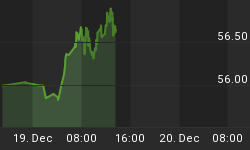A complete answer to the above question would necessitate a book (one we are not qualified to write). However, we'd like to just make a couple of points in response to a recent article by Frank Shostak titled "The Dollar and the Balance of Trade". In this article Dr Shostak asserts that it is 'purchasing power parity' and not the balance of trade that determines currency exchange rates. Using a simplistic example, this means that if 1kg of potatoes can be purchased with 1 US dollar in the US and 2 euros in Europe then US$1 is equivalent to 2 euros, that is, the US$/euro rate should be 2. In this example it would certainly be possible for the exchange rate to move a considerable distance from 2 in either direction, but it would eventually move back to purchasing power parity (2 euros = 1 dollar).
We are in partial agreement with Shostak's argument because a trade deficit can be thought of as an effect of a mismatch in purchasing power. In other words, if goods produced in Europe are cheaper than the equivalent goods in the US then US consumers will buy from Europe rather than buy the home-grown product. In this case the US would be in deficit with respect to trade with Europe. However, we think it is important to take into consideration the fact that trade in goods and services accounts for less than 10% of total international capital flows, with investment accounting for the remaining 90+%. So, even if purchasing power parity exists between the US and the EMU this could only bring approximately 10% of total capital flows into balance. What happens with the remaining 90% will be determined by the expectations of investors regarding future 'real' returns on dollar-denominated investments relative to euro-denominated investments. As such, if it takes an average of 24 dollars to buy one dollar of expected future company earnings in the US and only 12 euros to buy 1 euro of expected future company earnings in Europe, then the dollar might be vastly over-priced at a level of 1 euro = 1.17 dollars (the current rate) even if 1kg of potatoes cost the same in Europe and the US. In this example, one euro would need to buy two dollars in the foreign exchange market in order to achieve purchasing power parity at an investment level.
At the current exchange rate the US$ and the euro are probably close to achieving purchasing power parity as far as the prices of goods and services are concerned. As far as investments are concerned, whether or not purchasing power parity has been achieved will be determined by what investors expect the real returns in Europe and the US to be over the next 1-2 years.
Purchasing power parity at an investment level is difficult, or perhaps even impossible, to quantify because it is based on expected future returns. However, the effect of a disparity is observable in the currency market. For example, the dollar will continue to trend lower against the euro if investors are not sufficiently bullish on the US relative to Europe even if 1kg of potatoes costs a lot more in Europe than it does in the US.
Our view is that the dollar continues to sport an enormous investment premium - a premium that is evident in stock and bond market valuations (inflation-adjusted earnings, dividend and bond yields are very low) - relative to the euro and most other currencies. This, in turn, implies that the dollar is valued at a level that can only be sustained if investors throughout the world remain optimistic with regard to the prospects for US economic growth, earnings growth and interest rates.















